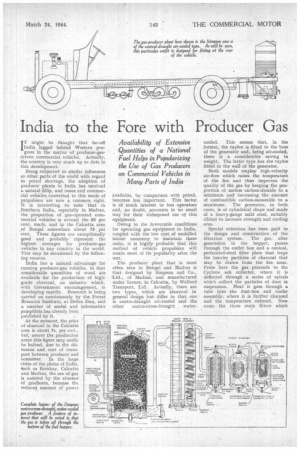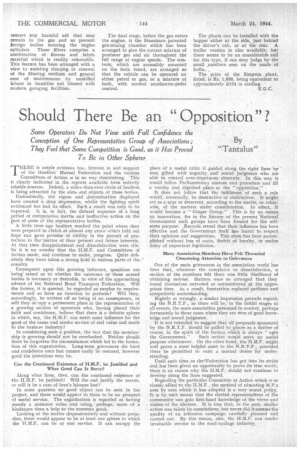India •to the Fore with Producer Gas
Page 31

Page 32

If you've noticed an error in this article please click here to report it so we can fix it.
IT might be thought that far-off India lagged behind Western progress in the matter of producer-gasdriven commercial vehicles. Actually, the country is very much up to date in this development.
Being subjected to similar influences as other parts of the world with regard to petrol shortage, the adoption of producer plants in India has received a natural fillip, and buses and commercial vehicles converted to this mode of propulsion are now a common sight. It is interesting to note that in ..Southern India, especially in Madras, the proportion of gas-operated commercial vehicles is around the 85 per cent. mark, and in the Calcutta area of Bengal somewhere about 75 per cent. These figures are exceptionally good and • probably represent the highest averages for producer-gas vehicles in any country in the world. This may be occasioned by the following reasons.
India has a natural advantage for running producer-gas vehicles, in that considerable quantities of wood are available for the production of high grade charcoal, an industry which, with Government encouragement, is developing rapidly. Research is being carried on continuously by the Forest Research Institute, at Dehra Dun, and a number of useful and informative pamphlets has already been published by it, At the moment, the price of charcoal in the Calcutta area is about 7s, per cwt., but, •nearer the production areas this. figure may easily be halved, due to the distances and cast of transport between producer and consumer. In the large cities of the plains of India, tuch as Bombay, Calcutta and Madras, the use of gas is assisted by the absence of gradients, because the reduced amount of power
available, by comparison with petrol, becomes less important. This factor, is of much interest to bus operators and, no doubt, accounts in no small way for their Widespread use of this equipment.
Owing to the favourable conditions for operating gas equipment in India, coupled with the low cost of unskilled labour necessary to maintain these units, it is highly probable that this method of vehicle propulsion will retain most of its popularity after the war.
The producer plant that is most often seen in Bengal and Madras is that designed by Simpson and Co., Ltd., of Madras, and manufactured under licence, in Calcutta, by Walford Transport, Ltd. Actually, there are two types, which are identical in general design but differ in that one is centre-draught air-cooled and the other centre-cross-draught water
cooled. This means that, in the former, the tuyere is fitted to the base of the generator and, being air-cooled, there is a considerable saving in weight. The latter type has the tuyere fitted in the wall of the generator. .
Both models employ high-velocity air-flow which raises the temperature of the fire and thus improves the quality of the gas by keeping the proportion of useless carbon-dioxideto a minimum and increasing the amount of combustible carbon-monoxide to a maximum. . The generator, in both cases, is of cylindrical shape and made of a heavy-gauge mild steel, suitably ribbed to increase strength and cooling area.
Special attention has been paid to the design and construction of the filtration system. The gas, after generation in the hopper, passes through the outlet box and a conical, perforated-steel filter plate that traps the heavier particles of charcoal that may be drawn from the fire zone. From here the gas proceeds to the Cyclone ash collector, where it is deflected through a series of spirals which collect the particles •of dust in suspension. Next it goes through a tube into the dust-box and cooler assembly, where it is further cleansed and the temperature reduced. Now come the three main filters which
remove any harmful ash that may remain in the gas and so prevent foreign bodies entering the engine cylinders These filters comprise a combination of fibrous and fabric material which is readily removahle. This feature has been arranged with a view to assisting cleaning or renewal of the filtering medium and general ease of maintenance by unskilled labour in localities not blessed with modern garaging facilities.
The final stage, before the gas enters the engine, is the Stansimco patented gas-mixing chamber which has been arranged to give the correct mixtuee of producer gas and air throughout the full raege of engine speeds. The controls, which are accessibly mounted on the facia board, are arranged so that the vehicle can be operated on either petrol or gas, or a mixture of both, with normal accelerator-pedal control. The plants can be installed with the hopper either at the side, just behind the driver's cab, or at the rear. A trailer version is also available, but there seems to be no considerable call for this type, if one may judge by the small ,numbers seen on the roads of The price of the Simpson plant, fitted, is Rs. 1,650, being equivalent to approximately £124 in sterling. ,




















































